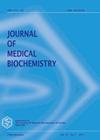乳腺癌患者乳头溢液中CA125、CA153、CEA的表达及临床意义
IF 1.5
4区 医学
Q4 BIOCHEMISTRY & MOLECULAR BIOLOGY
引用次数: 0
摘要
背景:通过对乳头溢液成分的检测和分析,是鉴别乳头溢液引起的乳腺良恶性疾病的重要临床手段。本研究旨在检测乳腺癌患者乳头溢液中碳水化合物抗原125 (CA125)、碳水化合物抗原153 (CA153)和癌胚抗原(CEA)的表达及其临床意义。& # x0D;方法:选取2017年1月~ 2018年12月86例浸润性乳腺导管癌伴乳头溢液患者(乳腺癌组)和50例普通乳腺导管增生伴乳头溢液患者(良性对照组),采用电化学发光免疫分析法检测两组患者乳头溢液及血清CA125、CA153、CEA水平。结果:良性对照组乳头溢液及血清CA125、CA153、CEA水平显著低于乳腺癌组,血清CA125、CA153、CEA水平明显低于乳腺癌组。乳腺癌组乳头溢液中CA125、CA153、CEA的表达水平在不同发病年龄、不同肿瘤部位差异无统计学意义。肿瘤直径为n5 cm、低分化、高分期、转移、复发患者乳头溢液中CA125、CA153、CEA水平明显高于肿瘤直径为n5 cm、高分化、低分期、无转移、复发患者。这些水平与雌激素受体(ER)和孕激素受体(PR)的表达不显著相关,但与人表皮生长因子受体(HER-2)和Ki-67的表达显著相关。乳头溢液CA125、CA153、CEA联合检测诊断乳腺癌的准确性、敏感性及阴性预测值均较血清联合检测及单项检测明显提高。 结论:乳头溢液中CA125、CA153、CEA联合检测可视为乳腺癌的潜在诊断方法,是血清学诊断的有效补充,可为乳头溢液良恶性乳腺癌的鉴别诊断提供新思路。本文章由计算机程序翻译,如有差异,请以英文原文为准。
Expression and clinical significance of CA125, CA153 and CEA in nipple discharge of breast cancer patients
Background: It is an important clinical means to identify benign and malignant breast diseases caused by nipple discharge through the detection and analysis of components in nipple discharge. This study was aimed to test the expression and clinical significance of carbohydrate antigen 125 (CA125), carbohydrate antigen 153 (CA153) and carcinoembryonic antigen (CEA) in nipple discharge of breast cancer patients.
Methods: From January 2017 to December 2018, 86 patients with invasive ductal carcinoma of the breast with nipple discharge (breast cancer group) and 50 patients with ordinary breast duct hyperplasia with nipple discharge (benign control group) were selected, and the nipple discharge and serum CA125, CA153 and CEA levels in the two groups were detected by electrochemiluminescence immunoassay.
Results: The nipple discharge and serum CA125, CA153 and CEA levels in the benign control group were significantly lower than those in the breast cancer group, and the serum CA125, CA153 and CEA levels were obviously lower than those nipple discharge levels. The expression levels of CA125, CA153 and CEA in nipple discharge in the breast cancer group had no significant difference in different age of onset and different tumor sites. The CA125, CA153 and CEA levels in nipple discharge of patients with tumor diameter n5 cm, low differentiation, high stage, metastasis, and recurrence were obviously elevated versus to those of patients with tumor diameter <5 cm, high differentiation, low stage, and no metastasis and recurrence. These levels were not significantly correlated with the expression of estrogen receptor (ER) and progesterone receptor (PR), but was significantly correlated with the expression of human epidermal growth factor receptor (HER-2) and Ki-67. The accuracy, sensitivity, and negative predictive value of nipple discharge CA125, CA153 and CEA combined tests in the diagnosis of breast cancer were markedly improved compared with serum combinations and individual tests.
Conclusion: The combination of CA125, CA153 and CEA in nipple discharge can be considered as a potential diagnostic method for breast cancer, which is an effective supplement to serological diagnosis, and can provide new ideas for the differential diagnosis of benign and malignant breast cancer with nipple discharge.
求助全文
通过发布文献求助,成功后即可免费获取论文全文。
去求助
来源期刊

Journal of Medical Biochemistry
BIOCHEMISTRY & MOLECULAR BIOLOGY-
CiteScore
3.00
自引率
12.00%
发文量
60
审稿时长
>12 weeks
期刊介绍:
The JOURNAL OF MEDICAL BIOCHEMISTRY (J MED BIOCHEM) is the official journal of the Society of Medical Biochemists of Serbia with international peer-review. Papers are independently reviewed by at least two reviewers selected by the Editors as Blind Peer Reviews. The Journal of Medical Biochemistry is published quarterly.
The Journal publishes original scientific and specialized articles on all aspects of
clinical and medical biochemistry,
molecular medicine,
clinical hematology and coagulation,
clinical immunology and autoimmunity,
clinical microbiology,
virology,
clinical genomics and molecular biology,
genetic epidemiology,
drug measurement,
evaluation of diagnostic markers,
new reagents and laboratory equipment,
reference materials and methods,
reference values,
laboratory organization,
automation,
quality control,
clinical metrology,
all related scientific disciplines where chemistry, biochemistry, molecular biology and immunochemistry deal with the study of normal and pathologic processes in human beings.
 求助内容:
求助内容: 应助结果提醒方式:
应助结果提醒方式:


